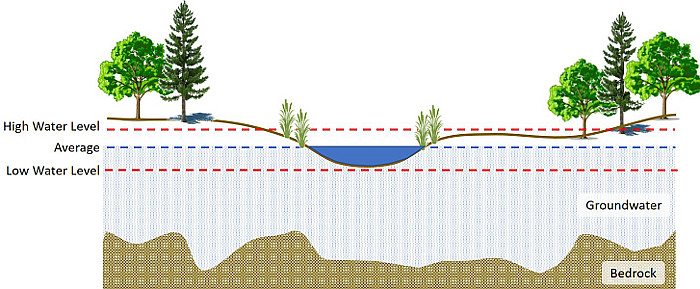Effects of High Groundwater Levels
Flooding can happen when frequent, sustained rainfall leads to excessively fast recharge of local groundwater levels and the water table rises above the land surface. This type of flood may be pronounced near seepage lakes (see diagram below). This type of flood can be long-lasting because water table decline requires drainage from the entire aquifer above the flood level. For the time that it takes for this drainage to occur, floodwaters can cause significant property loss, human displacement and disruption of transportation.
 Image from Groundwater levels and aquifer response | Wisconsin DNR
Image from Groundwater levels and aquifer response | Wisconsin DNRSeepage lakes may also experience flooding of shoreline beaches and buildings due to a rise in the water table elevation and the related long-term increase in lake levels. A seepage lake is a natural lake fed by precipitation, limited runoff and groundwater and does not have a stream outlet. Seepage lakes can be particularly sensitive to fluctuations in groundwater levels and more prone to flooding because there is no stream outlet by which the additional water volume can exit the lake. Floods and droughts are part of life in Wisconsin and elsewhere, but they come with significant economic, public health and environmental costs.
Over the past several years, Wisconsin has received a record-breaking amount of precipitation. Climate change has affected rainfall events by increasing the likelihood that they will occur with much more intensity and frequency. The accumulation of above-average precipitation has resulted in many areas of Wisconsin experiencing high water and flooding issues. Information is available from the DNR to help residents cope with flooding.
Department staff in many programs statewide are involved with data tracking, analysis and regulatory enforcement of a variety of issues (property/landowner, flooding response and mitigation, etc.) that are affected by groundwater levels. Please see the "Related Links" in the right sidebar for additional information and resources related to high groundwater levels managed by different department programs.
Please note that there may be additional information and resources available to assist with flood mitigation through local government ordinances or programs (towns and counties) as well as assistance and potential funding from the federal government.
